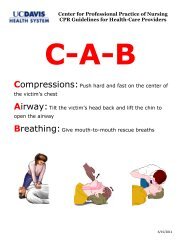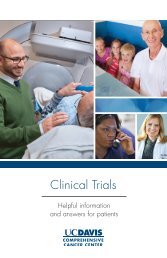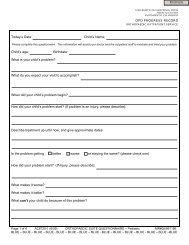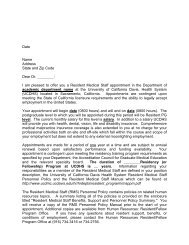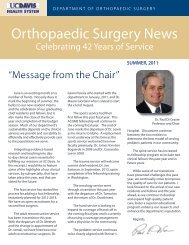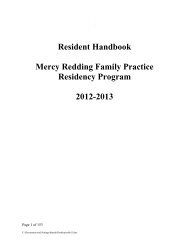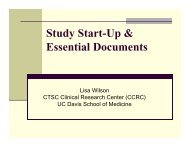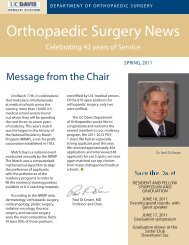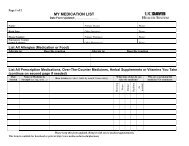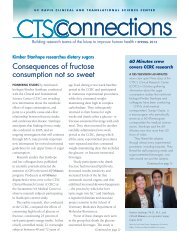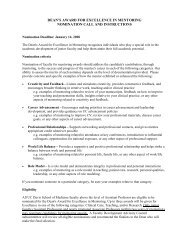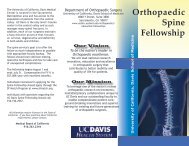Invent The Future - UC Davis Health System
Invent The Future - UC Davis Health System
Invent The Future - UC Davis Health System
You also want an ePaper? Increase the reach of your titles
YUMPU automatically turns print PDFs into web optimized ePapers that Google loves.
TAVR: It’s a Career, Not Just a<br />
Procedure!<br />
Jeffrey A Southard, MD<br />
Cardiology<br />
May 5, 2012
Transcatheter Aortic Valve<br />
• T- eam<br />
• A- pproach to<br />
• V- alve<br />
• R- eplacement<br />
Replacement<br />
<strong>UC</strong>DMC Team<br />
• Administration<br />
• Cardiology<br />
• CT Surgery<br />
• Anesthesia<br />
• Nurses<br />
• Cath Lab Techs<br />
• Perfusionists<br />
• Echo staff<br />
• Ancillary support
Before You Start<br />
• Do you have a hybrid OR?<br />
• Do you have the necessary equipment?<br />
• Do you have the necessary staff?<br />
• Are you sure you want to do this?<br />
• Novelty wears off very fast!<br />
• <strong>The</strong>se patients are very old, very needy<br />
and have lots of concerned family!
Aortic Stenosis<br />
• Symptomatic Aortic Stenosis - Surgical Aortic<br />
Valve Replacement is the standard of care<br />
• Surgical Aortic Valve Replacement - Mortality<br />
Risk<br />
Isolated AVR - 3.3 to 5.7%<br />
AVR with CABG - 6.8 to 7.3%<br />
• Percutaneous Aortic Valve Implantation in high<br />
risk aortic stenosis patients - feasible and safe
– Etiology<br />
Calcific degenerative<br />
Aortic Stenosis<br />
• Degenerative process with proliferative &<br />
inflammatory changes, lipid accumulation, up<br />
regulation ACE, infiltration with macrophages & T<br />
lymphocytes . Bone formation (vascular<br />
calcification)<br />
Congenital - Bicuspid<br />
• Turbulent flow - traumatizes leaflet<br />
fibrosis, rigidity, calcification & narrowed orifice<br />
Rheumatic<br />
• Adhesion & fusion of commissures & cusps<br />
retraction & stiffening cusps borders.<br />
• Calcific nodules both surfaces - small round or<br />
triangular opening
PERCENT SURVIVAL<br />
100<br />
80<br />
60<br />
40<br />
20<br />
Latent Period<br />
(Increasing obstruction<br />
Myocardial overload)<br />
Onset Severe<br />
Symptoms<br />
Prolonged latent period - morbidity & mortality very low<br />
Symptomatic aortic stenosis - Cardinal symptoms<br />
Angina • Syncope • Heart failure<br />
Onset of symptoms - Outlook changes dramatically<br />
Average survival 2 - 3 years - High risk of sudden death<br />
Management decisions based on these data<br />
Asymptomatic - Conservative treatment<br />
Symptomatic - Aortic Valve Replacement<br />
Angina<br />
Syncope<br />
Failure<br />
2 3 5<br />
AV. SURVIVAL YEARS<br />
Average age death (males)<br />
40 50 60 63 70 80<br />
AGE, YEARS
TAVI<br />
Trans<br />
femoral<br />
High Risk TF<br />
1:1 Randomization<br />
VS<br />
PARTNER Study Design<br />
ASSESSMENT:<br />
Transfemoral Access<br />
Surgical<br />
AVR<br />
Symptomatic Severe Aortic Stenosis<br />
TAVI<br />
Trans<br />
femoral<br />
ASSESSMENT: High Risk AVR Candidate<br />
3105 Total Patients Screened<br />
High Risk TA<br />
1:1 Randomization<br />
Surgical<br />
AVR<br />
Primary Endpoint: All Cause Mortality<br />
(1 yr) (Non-inferiority)<br />
VS<br />
Total = 1058 patients<br />
n= 700 High Risk 2 Parallel Trials:<br />
Inoperable n=358<br />
Individually Powered<br />
TAVI<br />
Trans<br />
femoral<br />
1:1 Randomization<br />
VS<br />
ASSESSMENT:<br />
Transfemoral Access<br />
Standard<br />
<strong>The</strong>rapy<br />
(usually BAV)<br />
Not In Study<br />
Primary Endpoint: All Cause Mortality<br />
over length of trial (Superiority)
Absolute Reduction in Mortality Continues<br />
to Diverge at 2 Years<br />
8
30% Absolute Reduction in Cardiovascular<br />
Mortality<br />
9
Valve Clinic<br />
• Must have a dedicated valve clinic<br />
• Must have a dedicated valve nurse<br />
• Must have CT surgeons with you in clinic<br />
• Should have multiple screening exams<br />
done before patients are seen in clinic<br />
• Janine will go over screening exams<br />
• All data must be submitted online to<br />
Edwards for approval
Valve Size Selection<br />
• <strong>The</strong> SAPIEN valve is intended to be implanted in a native annulus<br />
size range comparable to the following TEE measurements:<br />
Annulus diameter<br />
by TEE<br />
Valve Size to Annulus Diameter<br />
23 mm valve<br />
11<br />
26 mm valve<br />
18 mm 19 mm 20 mm 21 mm 22 mm 23 mm 24 mm 25 mm
Valve Size Selection<br />
• In annulus diameters 21 mm and 22 mm, either a 23 mm or 26 mm<br />
valve may be implanted<br />
Annulus diameter<br />
by TEE<br />
Valve Size to Annulus Diameter<br />
23 mm valve<br />
12<br />
26mm valve<br />
18 mm 19 mm 20 mm 21 mm 22 mm 23 mm 24 mm 25 mm
23 mm or 26 mm Valve?<br />
• <strong>The</strong> primary goal of aortic valve implantation is to maximize the<br />
effective orifice area and reduce the mean and peak pressure<br />
gradients<br />
– When possible a 26 mm valve should be implanted in annulus diameters<br />
21 mm and 22 mm Effective Orifice Area*<br />
Effective Orifice Area (cm2)<br />
3.0<br />
2.5<br />
2.0<br />
1.5<br />
1.0<br />
0.5<br />
0.0<br />
23 mm valve 26 mm valve<br />
13
Transfemoral Room Setup<br />
Members of the Heart Team present in the TAVR procedure:<br />
• IP: Implanting physician (Room-setup shown for transfemoral procedure)<br />
• PA: Physician’s Assistant<br />
• CTS: Cardiothoracic Surgeon<br />
• A: Anesthesiologist<br />
A<br />
Fixed C-arm<br />
Ideal room size is >800ft 2<br />
OR/CCL<br />
Staff<br />
E<br />
• E: Echocardiographer<br />
• P: Perfusionist<br />
• DPL: Device Prep Lead<br />
• OR/CCL Staff: Operating Room/Cardiac Cath Lab Staff<br />
IP* PA CTS<br />
14<br />
Edwards Product<br />
Preparation Table (≥150cm)<br />
DPL<br />
RAPID PACER<br />
OR/CCL<br />
Staff<br />
OR/CCL<br />
Staff<br />
OR/CCL<br />
Staff<br />
P
Prepare the Patient<br />
• RIJ large sheath and PA catheter<br />
• Radial arterial line<br />
• General Anesthesia<br />
• Oral Gastric Tube<br />
• Foley catheter<br />
• Full surgical prep<br />
• TEE probe in place<br />
• Defibrillator pads in place<br />
• IABP leads on the patient
Puncture Site<br />
17
9000TFX<br />
Edwards SAPIEN Transcatheter<br />
Heart Valve<br />
9100CR23<br />
Crimper<br />
RetroFlex 3 Transfemoral <strong>System</strong><br />
23 mm RetroFlex 3 Transfemoral <strong>System</strong><br />
9120FS23<br />
RetroFlex 3 Transfemoral<br />
Delivery <strong>System</strong><br />
9120BC20 (20 mm x 3 cm)<br />
RetroFlex<br />
Balloon Catheter<br />
20<br />
96402 (25 mL)<br />
Two Atrion QL2530<br />
Inflation Devices<br />
9120S23 (22F)<br />
RetroFlex<br />
Introducer Sheath Set<br />
9100DKS7<br />
RetroFlex Dilator Kit
9000TFX<br />
Edwards SAPIEN Transcatheter<br />
Heart Valve<br />
9100CR26<br />
Crimper<br />
RetroFlex 3 Transfemoral <strong>System</strong><br />
26 mm RetroFlex 3 Transfemoral <strong>System</strong><br />
9120FS26<br />
RetroFlex 3 Transfemoral<br />
Delivery <strong>System</strong><br />
9120BC23 (23 mm x 3 cm)<br />
RetroFlex<br />
Balloon Catheter<br />
21<br />
96402 (25 mL)<br />
Two Atrion QL2530<br />
Inflation Devices<br />
9120S26 (24F)<br />
RetroFlex<br />
Introducer Sheath Set<br />
9100DKS7<br />
RetroFlex Dilator Kit
Edwards SAPIEN Valve<br />
Model 9000TFX<br />
Edwards SAPIEN Valve<br />
• 23 mm and 26 mm valve sizes<br />
• Stainless steel frame<br />
• Bovine pericardial tissue<br />
• Carpentier-Edwards <strong>The</strong>rmaFix process*<br />
*No clinical data are available which evaluate the long-term impact of the Edwards Lifesciences tissue treatment in patients.<br />
22
Edwards Crimper<br />
Models 9100CR23 and 9100CR26<br />
9100CR23<br />
Uniquely designed to crimp transcatheter heart valves<br />
23<br />
9100CR26
RetroFlex 3 Delivery <strong>System</strong><br />
Tapered Distal End<br />
Articulating Delivery <strong>System</strong><br />
24<br />
Flex Catheter
Valve Crossing and Wire Exchange<br />
• Cross native valve with straight wire (suggestion: AL1 or AL2)<br />
• Can measure pressure gradients prior to wire exchange<br />
• Exchange 0.035” Amplatz extra-stiff wire with pre-shaped distal end in left ventricle<br />
– Ensure guidecath is advanced upon wire exchange to ensure exchange wire does not<br />
get caught in the mitral chordae.<br />
25
Rapid Ventricular Pacing:<br />
Test Run<br />
Effective Pulse Pressure and<br />
Blood Pressure Reduction<br />
• Set output to high setting to ensure proper capture<br />
• Note that there can be a delay between pacing onset and effective<br />
reduction of cardiac output<br />
27
• Rotate flex<br />
wheel to track<br />
over aortic arch<br />
Tracking Over Aortic Arch<br />
• Use LAO 30 to<br />
40 to provide<br />
view of aortic<br />
arch<br />
28<br />
• Catheter flexes<br />
away from the<br />
flush port<br />
• Five rotations of<br />
the flex wheel<br />
for full flex
Crossing Native Valve<br />
• Flex catheter should be fully flexed to<br />
pull wire out of commissure<br />
• Always keep delivery system and<br />
SAPIEN valve directly adjacent to<br />
support crossing the native valve<br />
• DO NOT FORCE THE VALVE<br />
• Use short movements to prevent<br />
“jumping” of the valve into the ventricle<br />
• Use RAO or AP projection for crossing<br />
to visualize the wire in the ventricle<br />
Tip extends 4.5 cm past<br />
crimped valve<br />
29<br />
4.5 cm
Final Positioning<br />
• Fluoroscopy should be the<br />
primary method of<br />
visualization for positioning<br />
and deployment<br />
• Use of TEE will assist with<br />
positioning<br />
• Position the Edwards<br />
SAPIEN valve:<br />
– 50% to 60% ventricular<br />
– Valve positioning should be<br />
coaxial<br />
30<br />
50% - 60%
Edwards SAPIEN<br />
Valve<br />
Valve Foreshortening<br />
Crimped Height Expanded Height<br />
23 mm 16 mm 14 mm<br />
26 mm 18 mm 16 mm<br />
23 mm SAPIEN Valve<br />
16 mm<br />
23 mm SAPIEN Valve<br />
16 mm<br />
32<br />
<strong>The</strong> Edwards SAPIEN valve foreshortens<br />
approximately 2 mm for both size 23 mm<br />
and 26 mm<br />
23 mm SAPIEN Valve<br />
14 mm<br />
23 mm SAPIEN Valve<br />
14 mm
Assessing Aortic Regurgitation:<br />
TEE<br />
• 2D TEE provides better visualization than TTE<br />
• 3D TEE<br />
– Biplane Imaging allows real-time evaluation of both short and long axis<br />
34
•Reinsert introducer into sheath<br />
over guidewire<br />
•Carefully withdraw sheath into<br />
common femoral artery<br />
•Contrast can be injected<br />
contralateral or through the<br />
sheath to detect vascular damage<br />
•Withdraw sheath<br />
•Leave guidewire and<br />
contralateral pigtail in place<br />
Sheath Removal
Post Procedure Care<br />
• Monitor patients in ICU or CCU for 24<br />
hours<br />
• Monitor closely for potential post-op<br />
complications<br />
Bleeding<br />
Late AV block (ECG monitoring)<br />
CHF<br />
Renal dysfunction<br />
CVA
CCU/CTICU<br />
• Systolic blood pressure control<br />
Manage between 110 and 130 mmHg for<br />
the first 24 hours<br />
• Antiplatelet therapy<br />
81-325 mg aspirin PO QD<br />
Optional: Clopidogrel 75 mg PO QD for<br />
six months (or 250 mg ticlodipine PO<br />
BID for patients who are allergic to<br />
aspirin or clopidogrel)
Reimbursement?<br />
• CMS released a statement on May 1 st :<br />
<strong>The</strong>y will pay for TAVR in properly<br />
selected patients and appropriately<br />
selected sites.<br />
• Patients with severe symptomatic AS in<br />
whom 2 CT surgeons have deemed the<br />
patient not to be a candidate for<br />
standard surgery<br />
• Certain number of PCIs, AVRs<br />
experience etc.
Registry<br />
• Mandatory reporting of every case and<br />
follow up for at least one year.<br />
• Database is not cheap<br />
• Follow for complications and redo<br />
procedures as well as quality of life<br />
assessment.
A B<br />
Position & Fill Lumens<br />
Aortic Ring<br />
Ventricular Ring<br />
Guidewire Lumen<br />
C
Boston Scientific - Lotus TM Valve<br />
• Braided nitinol stent structure<br />
Radial expansion as it shortens<br />
• Bovine pericardial valve<br />
• Valve leaflets function during<br />
deployment<br />
• Repositionable<br />
• Retrievable at any point prior to<br />
release<br />
• Adaptive Seal<br />
• 23 mm, 27 mm - 18 French<br />
2007 2008 2009 2010 2011 2012<br />
First in Man 21 French<br />
European Trial<br />
First in Man 18 French<br />
European Trial<br />
European Trial<br />
CE Mark
Final Thoughts<br />
• <strong>The</strong> greatest new technology since<br />
stents- without question<br />
• Don’t rush into this, it is a career choice<br />
not a hobby<br />
• <strong>The</strong> patients aren’t going anywhere fast<br />
• Don’t do patients just to do patients!<br />
• <strong>The</strong>y better be able to recover or the<br />
procedure is not worth doing.
Thanks




